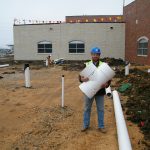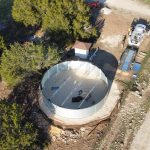Water Conservation 101
Got a Water Conservation Question?
The Need for Water Conservation
Every gallon of water saved means less water is drawn from ground sources, rivers, and reservoirs, and less energy is required to treat and deliver the water. This also means less wastewater is created and discharged.
Water conservation also helps cut down emissions from power and wastewater treatment plants. Remember that each gallon of water has been delivered by pumps from a water reservoir to its point of use. After it is used, energy is needed to transport the water to a centralized wastewater treatment facility; where it is aerated, settled, filtered, treated and then transported to a discharge point. There it is usually mixed with clean water so that the cycle can begin again.
What’s happening to water in the US?
What’s happening to water in the world?
Global water consumption has risen almost tenfold since 1900, and many parts of the world are now reaching the limits of their supply. World population is expected to increase by 45% in the next thirty years, whilst freshwater runoff is expected to increase by 10%. UNESCO has predicted that by 2020 water shortage will be a serious worldwide problem.
One third of the world’s population is already facing problems due to both water shortage and poor drinking water quality. Effects include massive outbreaks of disease, malnourishment and crop failure. Furthermore, excessive use of water has seen the degradation of the environment costing the world billions of dollars.
How to conserve in your home
- Check for leaks, especially faulty washers, and repair them!
- Install water conserving fixtures and devices
- Spray taps and faucet aerators are an alternative to steady flow taps enabling a smaller volume of water to achieve the same results.
- Low-flow shower heads can be installed to maximize water coverage and minimize
water volume. - In the toilet: By adding a sealed plastic bottle filled with water inside your toilet
tank or by adjusting your ballcock, the amount of water used per
flush can be reduced to a minimum. Alternatively a dual flush toilet system can
be installed which uses a small volume of water for liquid waste and a
larger volume for solid waste, efficient flushing depends upon the velocity of
the water rather than the volume which tends to be grossly out of proportion
with the waste that the water flushes. - Install a compost toilet, if appropriate: you can do away with using water to
flush away your wastes. The added benefit to this simple technology is the rich
compost you get at the end of the process, returning nutrients back to the soil
that would otherwise end up in rivers. In China and Japan night soil (as it is
called) has been scrupulously collected for centuries to fertilise the fields.
Compost toilets need no water and depend upon bacterial action to break down
harmful bugs in the waste.
- Think twice: much water conservation in the home is common sense:
- Washing clothes: Use full loads in your washing machine, or if purchasing a new unit,
look for water saving features such as half load capability or reduced water consumption. - Insulate hot water pipes to prevent the loss of heat in your water!
- Use showers instead of baths. Have baths as a treat, a sensual experience to be
relished once in a while. Take showers instead, and if you are very keen on
water conservation you can share your shower with a friend. - Collect rainwater. In many parts of the US, the water collected from rain
falling on the roof of an average house could supply the water needs of at
least one person provided that the water is stored. This collected water can be
used for most applications but care should be taken if you suspect any leaching
of particles from your roof surface. If this is the case then the water can
still be used for washing your car, watering your lawn and garden. - Car washing: It is possible to wash a car with only one bucket of water. But
does it really need washing? - Garden watering: To save water and to give your plants the maximum benefit, it
is best to water during early morning or in the evening. This will cut
down on water loss due to evaporation. Avoid sprinklers, which use water
indiscriminately, and try to target the water precisely where it is most
needed.
- Washing clothes: Use full loads in your washing machine, or if purchasing a new unit,
- Reuse your graywater: All the water used in the home, apart from blackwater, can be re-used to
some degree. This recycling can be facilitated by installing a graywater reuse system. Water can be collected from five main sources in the home:
- Shower
- Bath tub
- Bathroom sink
- Clothes washer
- Utility sink
How to conserve at your business
There are a wide variety of opportunities for businesses to reduce their water use and expense. Here are some quick ways that involve little or no up-front costs.
- Increase employee awareness of water conservation
Work with all employees to develop methods and procedures that will reduce water use. Evaluate how employees are using water and determine, with their help, more efficient alternatives. - Actually study your water bill each month
Compare the results to the same month of the previous year. This will help you to both identify leaks as they occur and monitor your conservation efforts. - Check for leaks
A leaking toilet can waste more than 50 gallons of water each day and a dripping faucet or showerhead can waste up to 1,000 gallons per week! - Install faucet aerators
Inexpensive and simple to install, low-flow faucet aerators can reduce your business’ water consumption as much as 50% and reduce your energy cost of heating the water also by as much as 50%. - Operate cooling towers & boilers according to manufacturers’ specifications
Reduce excessive blow-down. Many cooling towers operate below the suggested levels of total dissolved solids (TDS) unnecessarily. Adjust boiler and cooling tower blow-down rate to maintain TDS at levels recommended by manufacturers’ specifications. - Discontinue using water to clean paved areas
Instead of hosing down entrances, sidewalks, parking lots and loading docks, sweep or use a blower to clean these areas. - Wash vehicles only when necessary
If your business operates a fleet of vehicles, do not wash them on a regular schedule; instead wash them only when they are dirty. Consider washing the vehicles at a commercial car wash that recycles the water. - Review your landscaping practices
First, detect and repair all leaks in your irrigation systems. Make sure the sprinklers are watering the landscaping only – not the street or sidewalk. Water your landscape during the coolest part of the day and install moisture sensors to reduce unnecessary watering. Once you have incorporated these ideas into your work routine, upgrade inefficient equipment and processes. - Upgrade your irrigation systems
An inefficient irrigation system can cost your business hundreds or even thousands of dollars each month in wasted water. Upgrade your system so that it automatically shuts off when it’s raining, reads real-time ET for accurate irrigation run times and/or incorporates flow sensors that turn the system off in the event of leaks or broken heads. - Replace air conditioners and refrigerators
If your company’s air conditioners or refrigerators use water-cooled condensers, investigate air-cooled equipment for possible inefficiencies. - Install water-efficient toilets, urinals and faucets
Replacing toilets that use 3.5 gallons or more per flush, and urinals that use 2 gallons or more per flush, can often produce substantial savings. Low-flow faucets are also a sound alternative to those that use 1 gallon or more per minute. - Switch to efficient ice machines
Air-cooled ice machines are much more cost-effective and efficient than models that use water for cooling. Check to see if your ice machines are water or air-cooled. - Automate your cooling tower
Cooling towers, located at many large buildings, use water through evaporation and “blow-down.” Rebates are available for modifications to ensure the water blowdown is operated in the most efficient manner possible. - Reuse process water
Many industrial processes require heated or cooled process water. By reusing process water, your business can lower its water bill as well as its energy expenses.
Latest Water Conservation FAQ









